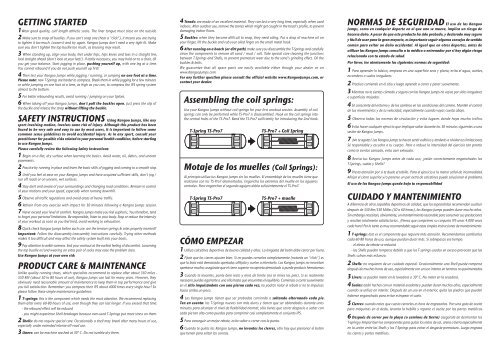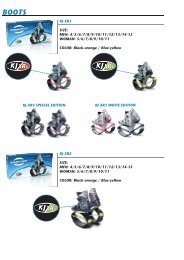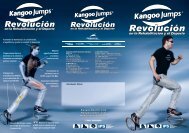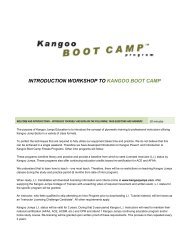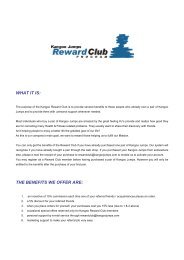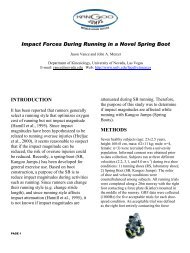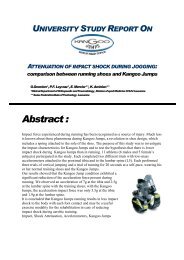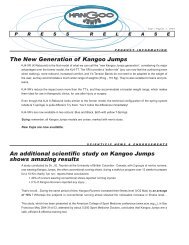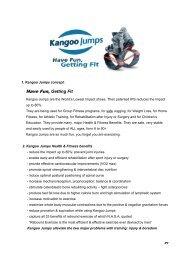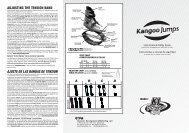GETTING STARTED PRODUCT CARE & MAINTENANCE ... - Kangoo
GETTING STARTED PRODUCT CARE & MAINTENANCE ... - Kangoo
GETTING STARTED PRODUCT CARE & MAINTENANCE ... - Kangoo
Create successful ePaper yourself
Turn your PDF publications into a flip-book with our unique Google optimized e-Paper software.
<strong>GETTING</strong> <strong>STARTED</strong><br />
1Wear good quality, cuff length athletic socks. The liner tongue must close on the outside.<br />
2 Make sure to snap all buckles. If you can't snap one (hear a "click"), it means you are trying<br />
to tighten it too much. Loosen it and try again. <strong>Kangoo</strong> Jumps don't need a very tight fit. Make<br />
sure you don't tighten the top buckle too much, as bruising may result.<br />
3 When standing up, align your body, feet under hips, hips knees and toes in a straight line,<br />
look straight ahead (don't look at your feet!). If really necessary, you may hold on to a chair, till<br />
you get your balance. Start jogging in place, pushing yourself up, with one leg at a time.<br />
You cannot rebound if you do not push yourself up first!<br />
4 Then test your <strong>Kangoo</strong> Jumps while jogging / running, or jumping on one foot at a time.<br />
Please note: new T-Springs are harder to compress. Break them in while jogging for a few minutes<br />
or while jumping on one foot at a time, as high as you can, to compress the IPS spring system<br />
almost to the bottom.<br />
5 For better rebounding results, avoid running / jumping on your tiptoes.<br />
6 When taking off your <strong>Kangoo</strong> Jumps, don't pull the buckles open. Just press the clip of<br />
the buckle and release the strap without lifting the buckle.<br />
SAFETY INSTRUCTIONS Using <strong>Kangoo</strong> Jumps, like any<br />
sport involving motion, involves some risk of injury. Although this product has been<br />
found to be very safe and easy to use by most users, it is important to follow some<br />
common sense guidelines to avoid accidental injury. As in any sport, consult your<br />
practitioner for possible risks related to your personal health condition, before starting<br />
to use <strong>Kangoo</strong> Jumps.<br />
Please carefully review the following Safety Instructions:<br />
1 Begin on a flat, dry surface when learning the basics. Avoid water, oil, debris, and uneven<br />
pavements.<br />
2 Practice by running in place and learn the basic skills of jogging and coming to a smooth stop.<br />
3 Until you feel at ease on your <strong>Kangoo</strong> Jumps and have acquired sufficient skills, don't jog /<br />
run off roads or on uneven, wet surfaces.<br />
4 Stay alert and aware of your surroundings and changing road conditions. Remain in control<br />
of your motions and your speed, especially when running downhill.<br />
5 Observe all traffic regulations and avoid areas of heavy traffic.<br />
6 Refrain from any exercise with impact for 30 minutes following a <strong>Kangoo</strong> Jumps session.<br />
7 Never exceed your level of comfort. <strong>Kangoo</strong> Jumps make you feel euphoric, You therefore, tend<br />
to forget your personal limitations. Be responsible, listen to your body. Stop or reduce the intensity<br />
of your workout as soon as you feel tired, avoid working to exhaustion.<br />
8 Quick check <strong>Kangoo</strong> Jumps before each use: are the tension springs & soles properly inserted<br />
Important: Follow the disassembly/reassembly instructions carefully. Trying other methods<br />
makes it too difficult and may affect the safety system built into your boots.<br />
9 Pay attention to ankle soreness. End your workout at the earliest feeling of discomfort. Loosening<br />
the top buckle or/and wearing an extra pair of socks may ease the problem area.<br />
Use <strong>Kangoo</strong> Jumps at your own risk<br />
<strong>PRODUCT</strong> <strong>CARE</strong> & <strong>MAINTENANCE</strong><br />
Unlike quality running shoes, which specialists recommend to replace after about 350 miles -<br />
550 KM (about 50 to 80 hours of use), <strong>Kangoo</strong> Jumps can last for many years. However, they<br />
obviously need reasonable amount of maintenance to keep them in top performance and give<br />
you full satisfaction. Remember: you compress their IPS about 4000 times every single hour! So<br />
please follow these simple maintenance guidelines:<br />
1 T-springs: this is the component which needs the most attention. We recommend replacing<br />
them after every 60-80 hours of use, even though they can last longer. If you exceed that time:<br />
- the rebound effect will be reduced<br />
- you might experience Shell breakages because over-used T-Springs put more stress on them.<br />
2 Shells: do not require special care. Occasionally a shell may break after many hours of use,<br />
especially under extended intense off-road use.<br />
3 Liners: can be machine washed at 30° C. Do not tumble dry them.<br />
4 Treads: are made of an excellent material. They can last a very long time, especially when used<br />
indoors. After outdoor use, remove the stones which might get caught in the tread's profile, to prevent<br />
damaging indoor floors.<br />
5 Buckles: when they become difficult to snap, they need oiling. Put a drop of machine oil on<br />
your finger, lift the buckle and rub your oiled finger on the small metal hook.<br />
6 After running on a beach (or dirt path) make sure you disassemble the T-Springs and carefully<br />
clean the components to remove all sand / mud / salt. Take special care cleaning the junctions<br />
between T-Springs and Shells, to prevent premature wear due to the sand's grinding effect. Oil the<br />
buckles & bolts.<br />
We guarantee that all spare parts are easily available either though your dealer or on<br />
www.<strong>Kangoo</strong>Jumps.com<br />
For any further question please consult the official website www.<strong>Kangoo</strong>Jumps.com, or<br />
contact your dealer.<br />
Assembling the coil springs:<br />
Use your <strong>Kangoo</strong> Jumps without coil springs for your first workout session. Assembly of coil<br />
springs can only be performed while TS-Pro7 is disassembled. Hook on the coil springs into<br />
the central holes of the TS-Pro7. Bend the TS-Pro7 sufficiently for introducing the 2nd hook.<br />
T-Spring TS-Pro7<br />
Motaje de los muelles (Coil Springs):<br />
Al principio utiliza tus <strong>Kangoo</strong> Jumps sin los muelles. El ensamblaje de los muelles tiene que<br />
realizarse con los TS-Pro7 desmontados. Engancha los extremos del muelle en los agujeros<br />
centrales. Para enganchar el segundo agujero dobla suficientemente el TS-Pro7.<br />
T-Spring TS-Pro7<br />
TS-Pro7 + Coil Spring<br />
TS-Pro7 + muelle<br />
CÓMO EMPEZAR<br />
1 Utiliza calcetines deportivos de buena calidad y altos. La lengüeta del botín debe cerrar por fuera.<br />
2 Fíjate que los cierres ajusten bien. Si no puedes cerrarlos completamente (notarás un "click") es<br />
que la bota está demasiado apretada; aflójala y vuelve a intentarlo. Las <strong>Kangoo</strong> Jumps no necesitan<br />
apretarse mucho; asegúrate que el cierre superior no aprieta demasiado o puede producir hematomas.<br />
3 Cuando te levantes, ponte bien recto y mira de frente (no te mires los pies). Si es realmente<br />
necesario puedes agarrarte a una silla hasta que encuentres el equilibrio. Comienza a correr suavemente<br />
en el sitio impulsándote con una pierna cada vez; no podrás notar el rebote si no te impulsas<br />
hacia arriba un poco.<br />
4 Las <strong>Kangoo</strong> Jumps tienen que ser probadas corriendo o saltando alternando cada pie.<br />
Ten en cuenta: los T-Springs nuevos son más duros y tienen que ser ablandados durante unos<br />
minutos para alcanzar el nivel de flexibilidad normal; sólo tienes que correr despacio o saltar con<br />
cada pie tan alto como puedas para comprimir casi completamente el conjunto IPS.<br />
5 Para conseguir un mejor rebote, evita saltar o correr con la punta.<br />
6 Cuando te quites las <strong>Kangoo</strong> Jumps, no levantes los cierres, sólo hay que presionar el botón<br />
que tienen para soltar las correas.<br />
NORMAS DE SEGURIDAD El uso de las <strong>Kangoo</strong><br />
Jumps, como en cualquier deporte en el que uno se mueve, implica un riesgo de<br />
hacerse daño. A pesar de que este producto ha sido probado, y declarado muy seguro<br />
y fácil de usar para la gran mayoría, es importante seguir algunos consejos de sentido<br />
común para evitar un daño accidental. Al igual que en otros deportes, antes de<br />
utilizar las <strong>Kangoo</strong> Jumps consulta a tu médico o entrenador por si hay algún riesgo<br />
relacionado con tu estado de salud.<br />
Por favor, lee atentamente las siguientes normas de seguridad:<br />
1 Para aprender lo básico, empieza en una superficie seca y plana; evita el agua, aceites,<br />
escombros o suelos irregulares.<br />
2 Practica corriendo en el sitio y luego aprende a correr y parar suavemente.<br />
3 Mientras no te sientas cómodo y seguro con las <strong>Kangoo</strong> Jumps no vayas por sitios irregulares<br />
o superficies mojadas.<br />
4 Sé consciente del entorno y de los cambios en las condiciones del camino. Mantén el control<br />
de tus movimientos y de tu velocidad, especialmente cuando vayas cuesta abajo.<br />
5 Observa todas las normas de circulación y evita lugares donde haya mucho tráfico.<br />
6 Evita hacer cualquier ejercicio que implique saltar durante los 30 minutos siguientes a una<br />
sesión de <strong>Kangoo</strong> Jumps.<br />
7 ¡No te agotes! Las <strong>Kangoo</strong> Jumps te hacen sentir eufórico y tenderás a olvidar tus limitaciones.<br />
Sé responsable y escucha a tu cuerpo. Para o reduce la intensidad del ejercicio tan pronto<br />
como te sientas cansado, evita caer exhausto.<br />
8 Revisa tus <strong>Kangoo</strong> Jumps antes de cada uso; ¿están correctamente enganchados los<br />
T-Springs, suelas y Shells<br />
9 Presta atención por si te duele el tobillo. Para el ejercicio a la menor señal de incomodidad.<br />
Aflojar el cierre superior y/o ponerse un par extra de calcetines puede solucionar el problema.<br />
El uso de las <strong>Kangoo</strong> Jumps queda bajo tu responsabilidad<br />
CUIDADO Y MANTENIMIENTO<br />
A diferencia de otras zapatillas deportivas de calidad, que los especialistas recomiendan sustituir<br />
después de 550 Km/350 Millas (50 a 60 horas), las <strong>Kangoo</strong> Jumps pueden durar mucho años.<br />
Sin embargo necesitan, obviamente, un mantenimiento razonable para conservar sus prestaciones<br />
y resulten totalmente satisfactorias. ¡Piensa que comprimes su conjunto IPS unas 4.000 veces<br />
cada hora! Por lo tanto es muy recomendable seguir estas simples instrucciones de mantenimiento:<br />
1 T-springs: éste es el componente que requiere más atención. Recomendamos cambiarlos<br />
cada 60-80 horas de uso, aunque puedan durar más. Si sobrepasas ese tiempo:<br />
- el efecto de rebote se reducirá<br />
- las Shells pueden romperse debido a que los T-springs usados en exceso provocan que las<br />
Shells sufran más esfuerzo.<br />
2 Shells: no requieren de un cuidado especial. Ocasionalmente una Shell puede romperse<br />
después de muchas horas de uso, especialmente con un uso intenso en terrenos no pavimentados.<br />
3 Liners: se pueden meter en la lavadora a 30° C. No meter en la secadora.<br />
4 Suelas: están hechas con un material excelente y pueden durar muchos años, especialmente<br />
cuando se utiliza en interior. Después de un uso en el exterior, quita las piedras que pueden<br />
haberse enganchado para evitar estropear el suelo.<br />
5 Cierres: cuando notes que cuesta cerrarlas es hora de engrasarlas. Pon una gota de aceite<br />
para máquinas en el dedo, levanta la hebilla y reparte el aceite por las partes metálicas.<br />
6 Después de correr por la playa (o caminos de tierra) asegúrate de desmontar los<br />
T-spring y limpiar bien los componentes para quitar los restos de sal, arena o tierra especialmente<br />
en la unión entre las Shells y los T-Springs para evitar el desgaste prematuro. Luego engrasa<br />
los cierres y partes metálicas.
1 2<br />
Liner<br />
3<br />
4<br />
Easy Buckles<br />
Hinge Feature<br />
DISASSEMBLING Using the step diagrams above you should<br />
proceed as shown in 1-4: When you detach the Lower Shell and the T-spring from the<br />
Upper shell (diagram steps 1, 2 & 3), using both hands, stretch your arms and use<br />
your body weight to apply some pressure to the end marked with a circle of the shell<br />
in order that it bows downwards, remove the lower shell. Again, using one hand this<br />
time, apply the same pressure method to the top shell, to the end marked with a<br />
circle, and bow enough to un-hook the T-spring. You will find it easier if you do this<br />
in a bounce like movement.<br />
REASSEMBLING Reverse the process above, applying the same methods.<br />
SRS (Safety Release System) In occasional situations, for instance<br />
when you do extreme sports or run on very uneven surfaces, there is a possibility that<br />
the lower shell pops off. If you want to exclude this situation, you must assemble<br />
your shells and the T-Spring with the SRS activated (fig. SRS on). To this effect, the<br />
marks you can see on the T-Spring and Shell ends, must coincide: circle with circle<br />
and triangle with triangle. To assemble the Shells with the SRS desactivated, (fig. SRS off),<br />
circles and triangles must NOT coincide (join circles with triangles).<br />
DESMONTAR Separa la Shell inferior colocando la bota entre los<br />
pies y aplicando ambos brazos y el peso del cuerpo sobre un extremo de la Shell, el<br />
que tenga la marca de un círculo, para curvarlo (fig. 1) y así poder separarlo (fig. 2).<br />
De nuevo, pero utilizando un brazo, aplica el mismo método de presión sobre el<br />
extremo de la otra Shell, el del círculo, y desengancha el T-Spring con la otra mano<br />
(fig. 3). Resulta más fácil si aplicas el impulso del cuerpo a movimientos rápidos,<br />
como un rebote.<br />
MONTAR Realiza el mismo proceso pero al revés aplicando los mismos métodos.<br />
SRS (Safety Release System) En raras ocasiones en que se hace<br />
ejercicio extremo o en terrenos irregulares existe la posibilidad de que se desmonten<br />
las Shell. Si quieres reducir esa posibilidad al máximo es conveniente montar las Shell<br />
con el sistema SRS activado (fig. SRS on) haciendo coincidir las marcas que podrás<br />
observar en los extremos de las Shell y los T-Spring (círculos con círculos y triángulos<br />
con triángulos). Para montar las Shell con el sistema SRS desactivado (fig. SRS off)<br />
hay que hacer que NO coincidan (unir círculos con triángulos)<br />
Clampings<br />
Non-Slip Tread<br />
Shells<br />
(Model Pro)<br />
Support Plate<br />
T-Spring<br />
(Model TS-Pro7)<br />
Coil-Spring<br />
TwinTurbos<br />
Congratulations! You have purchased the finest Rebound Exercise Shoes developed for<br />
the demanding athletes who want to Train Smarter.<br />
The KJ-Pro7 incorporates all the latest patented technology and is the most effective,<br />
efficient and versatile product available in it’s category.<br />
This <strong>Kangoo</strong> Jumps model KJ-Pro7 can return up to double the energy compared to the<br />
standard XR Series for the general public.<br />
Depending on the type of activity you want to use them for, you may want more or<br />
less “energy return”, that is, invest more or less energy to compress significantly the<br />
IPS (Impact Protection System). For example: jogging normally requires a “softer ride”<br />
- less energy return. Plyometric exercises require the maximum energy return.<br />
Both are made possible with the new versatile Tension Spring model TS-Pro7, on which<br />
you can add Steel Coil Springs, by simply hooking them on and off.<br />
INSTRUCTIONS & SAFETY GUIDE<br />
INSTRUCCIONES Y NORMAS DE SEGURIDAD<br />
SRS on<br />
SRS off


